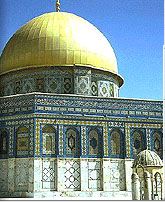|
|
|

The 'Double Gate'
|
The 'Double Gate', also known as the eastern Hulda Gate, is located in the southern wall of the Temple Mount. This gate was destroyed in 70 CE and was later repaired in the Early Islamic period in the framework of the restoration of the Temple Mount. Today a medieval (Fatimid?) building adjoining the Al-Aqsa Mosque covers the gate, and therefore only its eastern (right) quarter is visible. Since the gate is situated beneath the level of the Al-Aqsa Mosque, it seems probable that it was repaired before the construction of the Mosque, maybe in the days of `Abd al-Malik.
|
|
Of the original, Second-Temple-period gate the eastern doorjamb stone and the threshold have survived, as well as the entrance tunnel - completely preserved under the Al-Aqsa Mosque. The major repair works are visible on the gate's destroyed facade: a new lintel, lower than the original one, and doorjambs flanked by columns, which are adorned with Corinthian capitals. The new arched lintel protrudes from the southern wall. It is constructed of reddish stones, decorated with floral and geometrical motifs. These decorations are reminiscent of those adorning the Golden Gate. Above the lintel a relieving arch was built, and above it a cornice decorated with crenellations populated by floral motifs. The stones used in repairing the Double Gate are Herodian blocks, and reused Roman and Byzantine building stones. Set into the gate upside-down, above the east corner of the lintel, is a stone (statue base?) bearing a Latin inscription dedicated to the Roman Emperor Antonino Pio. The width of the stepped passage leading to the gate from the south was reduced in half during the Early Islamic period, and was accessible only to those visiting the Umayyad 'palaces'.
|
It seems that the blockage of the 'Double Gate' and of the 'Triple Gate' as well, should be attributed to the shifting of the city's eastern fortifications northward during the Fatimid period. During this period the eastern part of the area south of the Temple Mount was outside the city wall.
The Double Gate is identified by some of the Arab sources as the Gate of the Prophet, thus indicating the importance of this passage, which runs beneath the Al-Aqsa Mosque into the Temple Mount courtyard. This gate is mentioned in the Jerusalem Guidebook of the Cairo Geniza as the Huldah Gate. |

|


